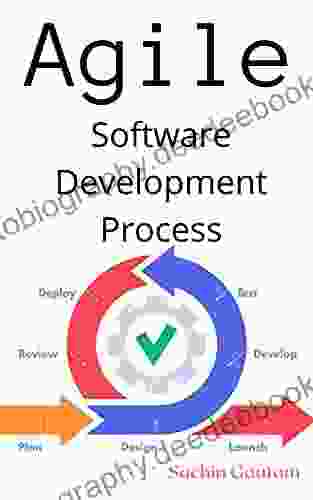Agile Software Development Process: A Comprehensive Guide

The agile software development process is an iterative and incremental approach to software development that helps teams deliver value to customers faster and with higher quality. It's based on the principles of continuous improvement, collaboration, and customer feedback.
In this article, we'll provide a comprehensive overview of the agile software development process, including its benefits, principles, practices, and tools. We'll also discuss some of the challenges of implementing agile and how to overcome them.
There are many benefits to using an agile software development process, including:
4.3 out of 5
| Language | : | English |
| File size | : | 2447 KB |
| Text-to-Speech | : | Enabled |
| Screen Reader | : | Supported |
| Enhanced typesetting | : | Enabled |
| Print length | : | 27 pages |
- Faster time to market: Agile teams can deliver value to customers faster because they work in short, iterative cycles. This means that they can get feedback from customers early and often, and make changes to the software accordingly.
- Higher quality software: Agile teams produce higher quality software because they focus on testing and continuous improvement. This means that they can catch defects early and prevent them from being released to customers.
- Increased customer satisfaction: Agile teams work closely with customers throughout the development process, which helps to ensure that the software meets their needs. This leads to increased customer satisfaction and loyalty.
- Improved team productivity: Agile teams are more productive because they work in a collaborative and supportive environment. This helps to reduce stress and burnout, and allows teams to focus on delivering value.
The agile software development process is based on the following principles:
- Customer satisfaction is the top priority: Agile teams focus on delivering value to customers, and they believe that the best way to do this is to involve them in the development process.
- Change is inevitable: Agile teams embrace change, and they believe that it is necessary to be able to adapt to changing requirements.
- Collaboration is essential: Agile teams work together closely, and they believe that the best way to achieve success is to share knowledge and ideas.
- Continuous improvement: Agile teams believe that there is always room for improvement, and they are constantly looking for ways to make their processes more efficient and effective.
There are many different agile software development practices, but some of the most common include:
- Scrum: Scrum is a framework for agile software development that helps teams to manage their work and track their progress. Scrum teams work in short, iterative sprints, and they use a backlog to track the work that needs to be done.
- Kanban: Kanban is a visual system for tracking work. Kanban boards are used to visualize the flow of work through the development process, and they help teams to identify bottlenecks and improve efficiency.
- Test-driven development (TDD): TDD is a practice in which developers write tests for their code before they write the code itself. This helps to ensure that the code is correct and meets the requirements.
- Continuous integration (CI): CI is a practice in which developers integrate their code changes into the main branch of the codebase on a regular basis. This helps to prevent merge conflicts and ensures that the codebase is always in a buildable state.
- Continuous delivery (CD): CD is a practice in which developers automate the process of building, testing, and deploying their code. This helps to reduce the risk of errors and ensures that software is delivered to customers quickly and reliably.
There are many different tools that can be used to support agile software development, including:
- Jira: Jira is a popular project management tool that can be used to track work, manage sprints, and generate reports.
- Asana: Asana is a collaboration tool that can be used to track tasks, share files, and communicate with team members.
- Jenkins: Jenkins is a continuous integration tool that can be used to automate the process of building, testing, and deploying code.
- Docker: Docker is a containerization platform that can be used to isolate applications from their underlying infrastructure.
- Kubernetes: Kubernetes is a container orchestration system that can be used to manage and scale containerized applications.
While agile software development offers many benefits, there are also some challenges that teams may face when implementing it. Some of the most common challenges include:
- Changing requirements: Agile teams need to be able to adapt to changing requirements, which can be difficult if the requirements are not well-defined.
- Lack of communication: Agile teams need to communicate effectively with each other and with customers, which can be difficult if there are language barriers or cultural differences.
- Team dynamics: Agile teams need to be cohesive and supportive, which can be difficult if there are personality conflicts or power struggles.
- Lack of experience: Agile software development is a complex process, and it can be difficult for teams to implement it effectively if they do not have experience with it.
There are a number of things that teams can do to overcome the challenges of agile software development, including:
- Define requirements clearly: Before starting development, teams should take the time to define the requirements clearly. This will help to reduce the risk of changing requirements and make it easier for teams to adapt.
- Communicate effectively: Teams should communicate effectively with each other and with customers. This includes using clear and concise language, and being respectful of different cultures and perspectives.
- Build a cohesive team: Teams should work to build a cohesive and supportive environment. This includes resolving conflicts constructively, and fostering a sense of camaraderie.
- Get experience: Teams should get experience with agile software development before implementing it. This can be done by attending training courses, reading books, or working with an experienced agile coach.
Agile software development is a powerful approach to software development that can help teams deliver value to customers faster and with higher quality. However, it is important to be aware of the challenges that teams may face when implementing agile, and to take steps to overcome these challenges.
By following the principles and practices of agile software development, teams can improve their productivity, deliver higher quality software, and increase customer satisfaction.
4.3 out of 5
| Language | : | English |
| File size | : | 2447 KB |
| Text-to-Speech | : | Enabled |
| Screen Reader | : | Supported |
| Enhanced typesetting | : | Enabled |
| Print length | : | 27 pages |
Do you want to contribute by writing guest posts on this blog?
Please contact us and send us a resume of previous articles that you have written.
 Book
Book Novel
Novel Page
Page Story
Story Genre
Genre Reader
Reader Library
Library E-book
E-book Magazine
Magazine Paragraph
Paragraph Sentence
Sentence Bookmark
Bookmark Shelf
Shelf Annotation
Annotation Footnote
Footnote Manuscript
Manuscript Tome
Tome Library card
Library card Encyclopedia
Encyclopedia Dictionary
Dictionary Thesaurus
Thesaurus Narrator
Narrator Character
Character Librarian
Librarian Catalog
Catalog Card Catalog
Card Catalog Borrowing
Borrowing Periodicals
Periodicals Study
Study Research
Research Scholarly
Scholarly Lending
Lending Journals
Journals Rare Books
Rare Books Special Collections
Special Collections Study Group
Study Group Dissertation
Dissertation Book Club
Book Club Theory
Theory Textbooks
Textbooks Christophe Guilluy
Christophe Guilluy Kerstin Wartberg
Kerstin Wartberg Caroline Heldman
Caroline Heldman Geoffrey Paul Lantos
Geoffrey Paul Lantos Caleb Cooper
Caleb Cooper Michael L Mullan
Michael L Mullan Helen Ellis
Helen Ellis Stephen O Donnell
Stephen O Donnell Dayna Kay Johnson
Dayna Kay Johnson Rosa Koire
Rosa Koire Jamie Merisotis
Jamie Merisotis Dennis Shirley
Dennis Shirley Rob Sanders
Rob Sanders Mary Frances Berry
Mary Frances Berry Mike Marqusee
Mike Marqusee Orlando Ricardo Menes
Orlando Ricardo Menes Kathleen Taylor
Kathleen Taylor Laurent Theis
Laurent Theis Kirkpatrick Hill
Kirkpatrick Hill John Reed
John Reed
Light bulbAdvertise smarter! Our strategic ad space ensures maximum exposure. Reserve your spot today!

 Kendall WardThe Ultimate Guide to Sheet Music for Piano: Finding, Reading, and Playing...
Kendall WardThe Ultimate Guide to Sheet Music for Piano: Finding, Reading, and Playing... Edwin CoxFollow ·7.7k
Edwin CoxFollow ·7.7k Colton CarterFollow ·7.4k
Colton CarterFollow ·7.4k Hudson HayesFollow ·4.3k
Hudson HayesFollow ·4.3k Chris ColemanFollow ·9.4k
Chris ColemanFollow ·9.4k Mason PowellFollow ·8k
Mason PowellFollow ·8k Jack LondonFollow ·8.1k
Jack LondonFollow ·8.1k Octavio PazFollow ·16.8k
Octavio PazFollow ·16.8k D'Angelo CarterFollow ·10.1k
D'Angelo CarterFollow ·10.1k

 Fletcher Mitchell
Fletcher MitchellEducation And Peace Montessori 10: Where Learning...
A Symphony of Learning and Well-being Amidst...

 Glen Powell
Glen PowellUnveiling the Wonders of Language and Literacy...
Language and literacy...

 Rod Ward
Rod WardThe Portable Benjamin Franklin: A Timeless Collection of...
In the vast tapestry of American history,...

 Kelly Blair
Kelly BlairDemocracy Versus Authoritarianism in the Post-Pandemic...
The COVID-19...

 Colin Richardson
Colin RichardsonGet Inspired To Shoot Over 130 Poses
Are you looking for...

 Jared Nelson
Jared NelsonEmbark on a Shadowy Journey: The Forbidden Wilds and...
Prologue: A Realm Enshrouded in Darkness As...
4.3 out of 5
| Language | : | English |
| File size | : | 2447 KB |
| Text-to-Speech | : | Enabled |
| Screen Reader | : | Supported |
| Enhanced typesetting | : | Enabled |
| Print length | : | 27 pages |










